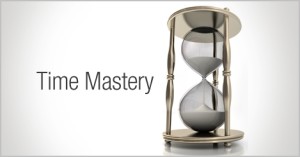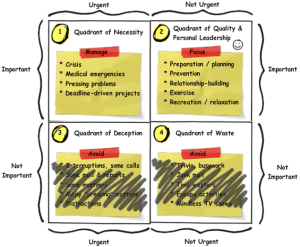Aug 5, 2014 | Self

How can you use a mindset of excellence to grow your business?
Imagine two business owners in the same market, with basically the same product and same target market, but the two businesses produce very different results. One is doing well, the other isn’t. One business owner seems on top of their game, the other isn’t. One business is growing, the other business is barely scraping by and the owner of the second business wonders whether it is either time to sell, or just shut the doors.
What is the difference between the two businesses? There are a number of possible factors, including the owners’ knowledge and ability to run the business, the systems that are in place and the team that drives the business forward. Pricing, marketing and sales all play a part as well. Many factors play into the successful, growing business. Yet, there is one characteristic that creates the largest differentiator between the two business environments. That is the mindset of the business owner. How do they look at each situation or economic obstacle, every customer, every challenge and life in general?
If your attitude is similar to Eeyore’s- the “woe is me” donkey that hangs with Winnie the Pooh—life is hard, this is what happened, I don’t get the same opportunities as others, the economy is really hurting, your results will reflect your attitude. Not taking responsibility is a “below the line” mindset of blame, excuses and denial. By blaming others, making excuses as to why things don’t get accomplished, and not taking accountability for your results, you remain a powerless victim to the world around you, and you become the main source of the issues plaguing the business.
Or is your attitude “above the line”? Do you as a business owner take ownership, accountability and responsibility for everything that happens in your business? You have the power to control everything that happens in 3 ways:
1) You control what you do
2) You control what you don’t do
3) You control how you respond to everything else
How your day goes is totally up to you, how you react to situations and what opportunities are ahead even through disasters. Steve Jobs got fired from Apple – not what he called the best day of his life, yet without being fired from Apple he would not have created Pixar and NeXT which are part of the foundation of the Apple products people love today. Above the line thinking creates empowerment, and empowerment creates results.
You can see the critical impact of attitude every day in the business world. What one business owner may see as a disaster, another business owner may see as an opportunity. People who have spent their lives in below the line thinking often don’t even realize the impact it has on them personally and in their families, businesses, customers and potential.
If you are below the line, so is your team, then the effects multiply exponentially. As a business owner, you set the tone for the business. An owner who is below the line will hire staff that will follow that lead and turn to blame, excuses and denial. It is someone else’s fault that the project is late, someone else’s fault that the customer is upset. To change, they will need someone to hold them accountable to point out where they are below the line.
As I work with clients on this concept, the tendency is to swing to a point where issues in the business are not discussed with an excuse. This doesn’t mean the business may white wash any issues it faces. It means empowerment to take ownership and responsibility for changing the issue. If projects are late, that is a fact. The question is what must change in the business to ensure projects are not delivered late. You have to take responsibility in order to improve the business.
If you want to reach your full potential, try taking responsibility for every single thing for one week. Everything will fit into one of the 3 categories above. Just do it for a week. How does it feel? What doors does it open for you when you have a responsibility mindset? What opportunities do you now consider that you might not have before? What impact could that have on your business? How much time and energy do team members waste just assigning blame? Where does that lead? How is the energy level in the business changing? What productivity improvements can you see potential for with an “above the line” attitude?
When I ask my clients if they want to be average, the resounding answer is NO. They want to be the best. To make that happen, your mindset must change to one of excellence or responsibility — above the line thinking — your results will be amazing.
Jul 15, 2014 | Planning & Goal Setting, Self

Have you ever seen – or experienced – a business partnership ending badly?
I’ve seen it often. My experience is that out of every ten business partnerships, eight don’t work, one works very well, and one is just okay.
Often, the ones that don’t work have run into problems with each partner’s expectations of the business. In other words, the partners have key differences in their vision, in their targets and what they are trying to achieve in the business and in their risk tolerance. There is conflict in the partnership when one partner wants to go faster than the other, one partner wants to take it easy, or one partner has a higher appetite for risk than the other.
That can mean that a couple of years down the track, one partner is working a bit harder than the other and resentment is starting to build. Or, the business needs a cash injection and one partner has the money and the other doesn’t. One wants to invest time and money in going after a new contract or market share, while the other is happy with a steady, reliable business. That’s when problems start to show up.
The trouble is that there is so much emotion and excitement in starting a new business that the partners often just didn’t talk about these kinds of issues before they got started. A successful partnership needs – clear communication, a lot of what-if planning, and a written set of goals and overarching strategies.
- What if one of the partners wants to leave the business? How will you manage a buy out?
- What if you need a lot of capital suddenly? Whose personal assets will and will not be available?
- How do each of you define “success” in the business? Is there a particular milestone you each want to reach?
- How will you know when the business is “finished”? Do you intended to sell it? Run it forever and keep it in the family?
- How many hours a week are you really comfortable working? What about after the first few years of intense work are over?
- How much of a financial return are you each expecting? Now, and ultimately? If you each have different skills, do you value your time equally?
- How much personal or business debt can you each cope with, before you begin losing sleep over it?
These are the kinds of questions you need to discuss, and put down in writing, to form the basis of a successful partnership. When you’re working together, you need to know what to expect from one another. If you can see from this exercise that your expectations are not aligning on a lot of points, then you may need to consider other options rather than going into partnership.
To find out more about how to become aligned with your partner or team, get in touch with me.
Jun 24, 2014 | Planning & Goal Setting, Self, Time Management

Eat That Frog: Last week was the third installment in Time Management – “Time Mastery “. Now that you’ve had time to develop your vision, set and write down your goals and learned how to prioritize all of your tasks, you’re ready to take the final step – developing the habits to keep you focused for long-term success.
Okay. So, you’ve started your day, and there’s so much to do. Ever ask yourself, “Where do I start?” This is the first sign of a day of little accomplishment ahead. Many business owners I talk to have way too much on their plate: sales, marketing, finances, hiring, and let’s not forget actually providing your product or service. Many people, faced with so many balls to juggle, find it hard just to get started, so they choose to start with email. You think, “its easy, I can get through it quickly and then move on to more important things”. I know you’ve done it. You might even do it routinely.
So you dive into your inbox. And then the phone rings. And then an employee comes in asking for guidance. And then a customer calls. And before you know it, it is 5 p.m. and everyone is leaving the office except you, and you’re thinking “Jeez, I haven’t gotten anything done that I needed to get done today.”
There’s a way to stop the cycle, and it’s called “Eat That Frog!” If you’ve read this time management series this far, and you haven’t read this book by Brian Tracy, go order it NOW.
You must develop a new habit that can change everything when it comes to achieving your goals. The key to getting the results you want from yourself is to START each day by doing the number one goal you have for the day. The best time to identify that task? The night before. Every day, the last thing you do at the end of your workday is WRITE DOWN your top 2-3 priorities for the next day. Then when morning comes, you’re ready to “Eat That Frog!”
What the heck? You might be asking about now. Mark Twain once said, if your list of things to do today includes eating a frog, do that first, and know nothing worse is going to happen the rest of the day. Your “frog” is the most important, and biggest task on your list – the one you are most likely to procrastinate about doing. Skip the inbox, skip the interruptions, get right down to eating that frog. Block out the time on your calendar, and stick to it.
Continually ask yourself “Which one project or activity, if I did it in an excellent and timely fashion, would have the greatest positive impact on my life?” And conversely, which one, “if I DON’T get it done, will have the most negative impact?” Then develop the habit of asking yourself throughout the day, “is this the best use of my time right now”. Did you eat your frog?
It takes 21 days on average to develop a new habit, after that you won’t have to think about it, you’ll just be doing it. Start today. Write out your frog for tomorrow. Then do it!
Get in touch with me to find out when my next time management workshop will be held.
Jun 17, 2014 | Planning & Goal Setting, Self, Time Management

Time Mastery – How To Get The Best of You
Time Mastery – Last week was the second installment in Time Management – “Setting Your Goals”. Now that you’ve had time to think about your vision, work out your ideal future state, and set and write down your specific SMART goals, you’re ready to take the next step – how to work on the RIGHT things to accelerate achievement of your goals.
Time Mastery is one of the most difficult and most critical challenges facing business owners today – how to efficiently utilize your most valuable resource – your TIME! The things that you choose to spend your time on in your business will have a significant influence on how successful you are as a business owner.
Stephen Covey in his “7 Habits” and “First Things First” books describes a simple matrix of Importance vs. Urgency to easily categorize how you allocate your time investment to have the most positive impact on achieving your goals. These four areas can also be called Waste, Deception, Necessity and lastly Quality & Leadership or Strategic.

You’ll find things like e-mail and surfing the web are most often Not Urgent and Not Important – or Waste. It is critical to avoid spending much time on these activities during the day. Many phone calls and walk in requests fall into the category of Urgent and Not Important. They come to you because someone else did not do what they were supposed to or because there is no process in place to handle the situation. Many customer calls or production issues are Urgent and Important. You handle them to satisfy a customer or keep the operation moving, but they suck time from you largely because there was no system in place to handle the issue properly in the first place. Does any of this sound familiar to you?
It might surprise you to know that the quadrant where you want to spend the most time is the Important and Not Urgent corner. This is where you find focus, and work on things like strategy, planning, goal setting and relationship building. The biggest challenge for you as business owner is to spend as much time as possible in this corner. These are the Strategic decisions that will determine where you take your business and if you accomplish your goals. Because the projects in this corner are not Urgent, they often times get pushed back in the priority stack – and then just get forgotten or just never done. As the business owner, it is your job to invest your TIME on these areas of your business. If you do not, who will?
So you ask, how do I make time to focus on the Not Urgent but Important? One practical idea is to bake it into your schedule. I call it using a Default Calendar. That is blocking the time on your calendar for those critical tasks you must do even though there is not an emergency driving them. When you put the BIG, CRITICAL items into your calendar first, you will always find time to fit in the other, smaller items.
And, related to this thought, when you put the big items into your calendar, FOCUS ON THEM! Resist the urge to blow right past them and put them off. Discipline yourself to focus first on the Strategic and them the operational and execution-oriented activities will flow more naturally.
Try it! If you have a white board in your office, draw the matrix there, and list your projects and activities in each quadrant. Make sure you are spending blocks of quality time in the Important & Not Urgent corner. How you spend your time will determine your ultimate level of success.
Need help with setting goals and planning? Our next GrowthClub 90 Day Planning & Strategy workshop is coming up on Sep 23rd. Its your chance spend a day in quadrant 2!
Jun 9, 2014 | Planning & Goal Setting, Self

Setting Your Goals. Last week was the first installment in Time Management – “Destination: Where are you going?” Now that you’ve had time to think about your vision and work out what your ideal state (for your life, business, career, etc.) looks like in 1, 5 or 10 years, you’re ready to take the next step and define the specific goals that will get you there.
Do you have written goals for your business? One year out, three years out? What about the next 90 days? If you don’t know very explicitly and clearly what your goals are, which determines your priorities, then how can you possibly know what is the best use of your hours TODAY? And how can you know if those goals will get you to your vision?
Many business owners operate without a real clear picture of the goals they have for their business. They seem to just go through the paces, week after week, without knowing whether they are ahead or behind on meeting their goals. I think the reason most business owners do this is because if they never commit to specific goals, then they can’t fail when they miss them. It keeps them from failing; it also keeps them from succeeding.
Goal setting, and using those goals to drive your daily priorities is a habit you can develop. Like any learned habit, typically will take at least 21 days to develop, and then many months and years to refine until you master the discipline.
There is a lot of material and advice out there about goal setting, but here is a simple and effective process for setting goals :
1. Decide exactly what you want. Be clear, specific and write it down on paper. The very act of writing down a goal significantly increases the likelihood that you will achieve it.
2. Make your goals measurable. Your goals should have clear metrics for their achievement. For example, a goal to “become the best salesperson” is a nice goal, but how do you measure “best”? To make this goal measurable, it could be restated in the following way, “I will achieve $1,000,000 in gross sales revenue, helping me reach the top sales position in the company.”
3. Make a list. Write down everything you must do to achieve each goal, including every step, actions, strategies, decisions, milestones, etc.
4. Set a deadline for each of your goals. This will help you overcome the human tendency to procrastinate and will exert some pressure for you to stay on task.
5. Finally, develop an action plan from the list of activities and immediately take action on your plan. Resolve to do something every day to get you closer to your goals.
Clearly written goals will have a powerful effect on your thinking and will motivate you into action. They act as the “guiding lights” to keep you on task, using your time in the most effective manner possible, keeping you focused on your priorities. Make a habit of asking yourself throughout the day if what you are doing right now is moving you towards your goals. If not, STOP what you’re doing and do something that will.
Need help with setting goals and planning? Our GrowthClub 90 Day Planning workshop is coming up on June 16th. It’s your chance to take a day out of your business to work ON your business!
Jun 4, 2014 | Planning & Goal Setting, Self

Is Time Management an oxymoron? Can you really manage time? Time marches on its own schedule, whether you like it or not, with or without you. You can’t manage time, but you can manage yourself, and what you do with your time. As your single most valuable resource, successfully leveraging time is critical to your success.
You can always make more money but you can’t make more time.
As you look at what you do with your most precious commodity, it only makes sense to start with the end in mind. Why is that important? Simply put – if you do not have a clear vision or goals in life or in business – then time management really becomes pointless. In other words, if you don’t know where you’re going any road will get you there, and what you do with your time doesn’t matter.
I did a seminar for NAWBO yesterday on TimeWise – how to properly invest your time, and it reminded me of how extremely valuable it is to master getting the best results from the investment of your time. There are tremendous tools and techniques for mastering it that most people don’t know about, or don’t use. So I’ve decided to do a series on the subject, this is part 1.
STEP ONE: DESTINATION – Where are you going?
A key element to develop effective time management is Vision. I know many people (and I’m sure you do as well) that waste so much precious time because they have little sense of purpose and vision. Therefore, they are doomed to live life, day to day, getting pulled this way and that, taking what comes and missing the possibilities that exist. Clarity is the most important concept when it comes to vision and personal productivity. The key reason why some people achieve more in a day than others (all things being equal) is due to the fact that they have complete clarity on their goals and objectives and don’t deviate from them. The discipline of clarity prevents procrastination and provides the focus and motivation that propels individuals to reach their dreams.
Let’s define vision. Vision can be described as your ideal state (for your life, business, career, etc.) in 1, 5, 10, 20 years and beyond. You should be able to picture this vision with absolute clarity and describe it with precise detail. The more clarity you have with your vision, the more motivation and focus you will have in your life. Commit to spending 2 hours developing and writing down, or drawing, your vision.
Having this clear vision will help you determine what you must do today in order to achieve what you want tomorrow. Once you have established a clear vision, it’s imperative to develop the goals that will help you achieve that vision. While vision is the destination, goals are the short and long-term milestones along the path that get you closer and closer to achieving your ultimate vision.
Do you have written goals for your life and your business? Next week I will talk more about setting goals. For today, focus on Vision, and developing a mindset of control over how you invest your time. You are responsible for how you choose to use your time. Its not anyone else’s fault, if you allow unimportant interruptions in your day, its your fault.
Developing the vision, and the right mindset and proper attitude sets the stage for creating effective time management habits and disciplines. Many of us feel chaos in our lives because we have not established the fundamental disciplines of time investment. You have to first believe your situation can change and that you have the power to overcome your ingrained habits. Once you have a firm desire and make the conscious decision to get control of your actions and behavior, you will then be open and prepared to learn and embrace the key disciplines and tools of effective time investment.
Where are you going?
Need help with setting vision or goals? Sign up for a free Business Health Check to get started.







